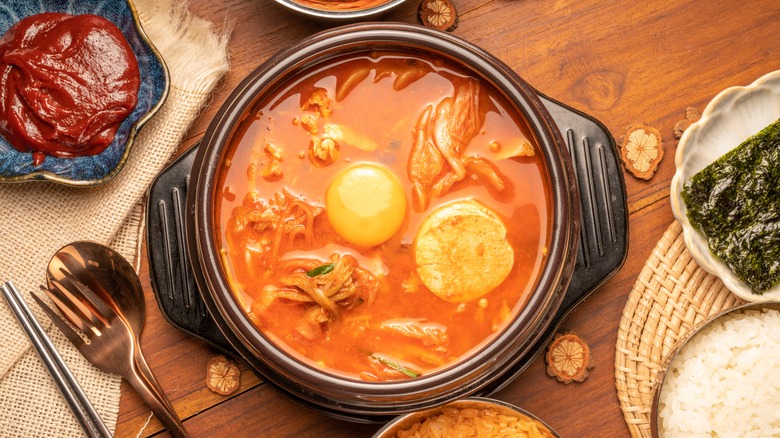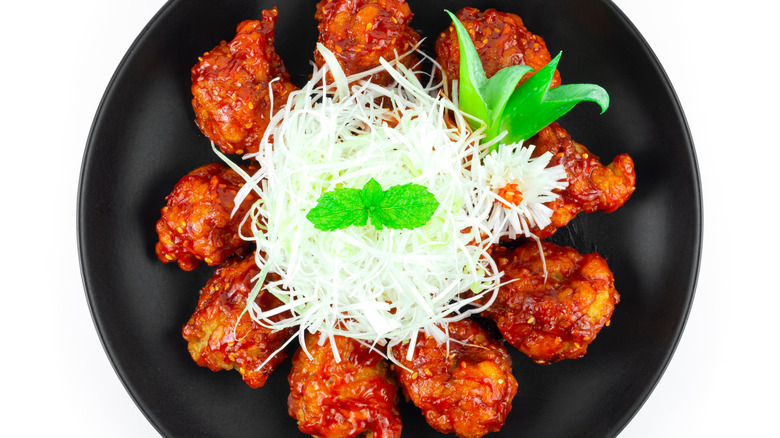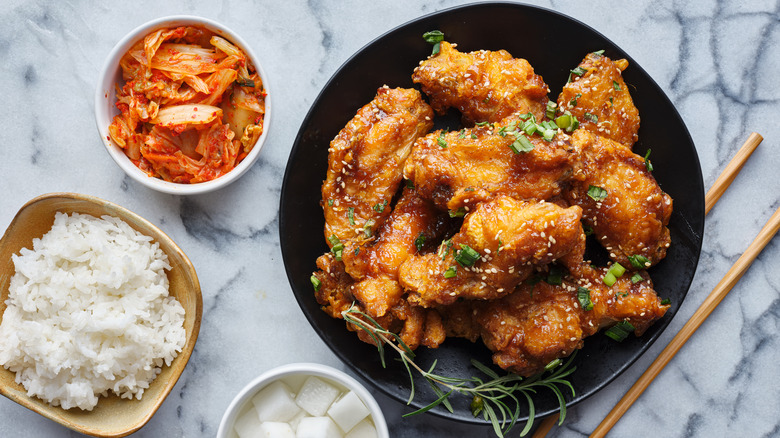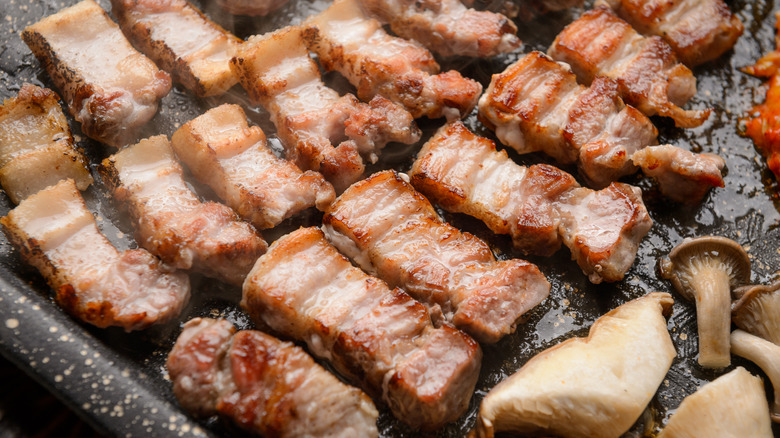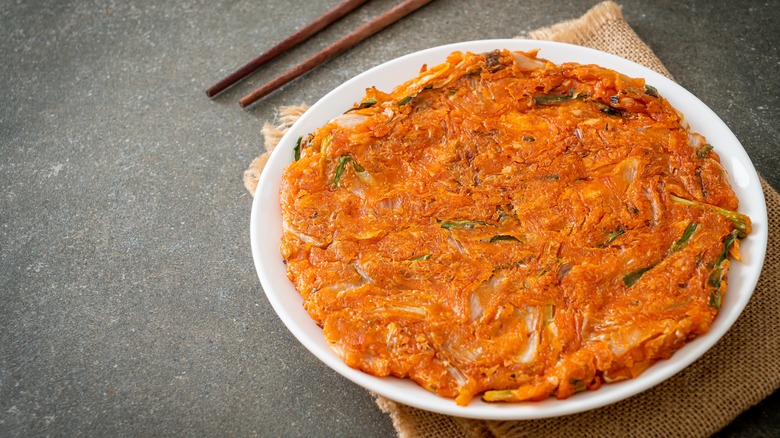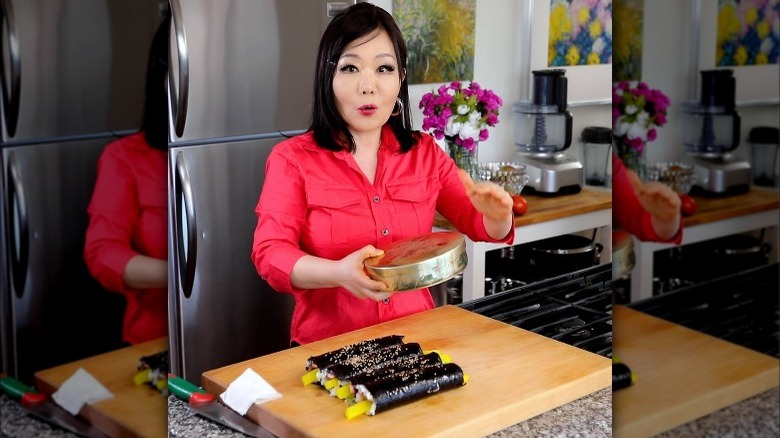Emily 'Maangchi' Kim Talks The New York Times Food Festival - Exclusive Interview
There is nothing better than a meal in one hand, a drink in another, and your favorite food personalities giving you cooking tips. If that sounds like the perfect day to you, then you probably already know about the New York Times Food Festival. The guest list includes the cooking world's most iconic faces, such as Ina Garten, Padma Lakshmi, and several cast members from Hulu's summer hit "The Bear." YouTube's Emily "Maangchi" Kim will also be making an appearance for a live kimchi-making demo, which we will most definitely be attending.
Nicknamed "YouTube's Korean Julia Child," Maangchi has made herself known to about 6.1 million YouTube subscribers through her traditional and creative Korean recipe videos. In an exclusive interview with Tasting Table, the cookbook author shared what makes Korean fried chicken so unique, the people she is most excited to meet at the festival, and her best tips for making kimchi. Maangchi even disclosed her upcoming social media project, which is definitely not what you'd expect.
Maangchi reveals what food she is demoing at the New York Times Food Festival
Let's first talk about the New York Times Food Festival, which you will be attending. I saw from your Instagram that you will be doing a live kimchi-making demo, which is exciting. Say someone is making kimchi for the first time. What would your tips be for them?
You should find really good, proper ingredients. Good ingredients make the cooking better, such as Napa cabbages in kimchi. When you choose them, you should look to see if the outer leaves are dark green and very refreshing looking. Also, I usually choose the leaves that are thinner, not thick. If the leaves are too thick, it contains a lot of acidic water inside, so we always choose the thinner leaves.
What are the biggest mistakes people make with kimchi?
People think that kimchi is only eaten when it's fermented. Lots of my readers will say that: "Oh, kimchi means waiting until it is fermented." Actually, all Koreans enjoy it from the beginning, right after making fresh kimchi. As the time goes, stage by stage, the taste is different. We enjoy it from the beginning to end.
How would you recommend storing kimchi? Sometimes there's a debate about that.
You can put it in some glass jars, glass containers — same with the steel containers, porcelain. [You can keep it] as long as weeks [or] until it runs out. You put it in the refrigerator, and as time goes by, the kimchi gets a little bit soggy. You still can eat it. Sometimes some people are like, "Age the kimchi." One year, two years in the refrigerator — no problem.
Maangchi names the food personality she can't wait to meet
Speaking of the festival, there are going to be a lot of big food names that are doing demos like you are, such as Ina Garten. Who are you most excited to meet?
You named it. Ina Garten. Actually, I'm a big fan of her because she's very knowledgeable and internet savvy and also down-to-earth, an approachable person. I'm excited to meet her, and also I want to meet my readers. When I told them I'm coming to the New York Times kimchi-making demo, they wanted to see and find me. I'm so excited to meet them, too.
Absolutely. Have you met Ina Garten before?
[We've] never met. I just saw her many times through the TV.
In your opinion, what is the most underrated U.S.-Korean food?
When I started for the first time by sharing my recipe, not many people knew about Korean food, but these days, a lot of people know. But one dish is the naengmyeon. They're cold noodles. Whenever I make it, that's my favorite. You need an acquired taste. A lot of people, the first time they try it, will say, "Well, what is it? Why are the noodles cold?" They don't like it. But once you get some familiarity with the dish, you love it. I can say this is delicious food and my favorite — cold noodles.
What really inspired Maangchi's buldak recipe
J. Kenji López-Alt used your buldak recipe for his hot chicken pizza dish. What is your favorite unexpected Korean-influenced recipe?
Several years ago, I was invited to one of my readers' houses. He made kimchi pizza for so many people, tens of people. We really enjoyed it. Around that time, nobody made something like it with the kimchi, but he had already added the kimchi as a topping. I enjoyed it. Ever since then, I see a lot of kimchi pizza, kimchi hot dogs, or kimchi hamburgers. I'm so impressed. Kimchi can be used in many ways.
Is it like a regular pizza with kimchi on top?
People will chop it up, and then they have their own way of cooking — as the stir fry or sometimes the raw kimchi as a topping — to use kimchi. [With] the hamburger, sometimes, instead of a hamburger bun, they use rice. Between them, they add the kimchi.
How would you recommend using rice as a bun like that?
I'd probably just make rice. Korean rice is usually sticky. Make this rice bowl, and make a thin disc shape, and pan fry with a little bit of oil in a bottle [until] they're toasty. Make it crunchy, and then use it as a bun.
The special ingredient Maangchi puts in her Korean fried chicken
You had a Korean fried chicken recipe that got over 21 million views, which is crazy. For those unfamiliar with Korean fried chicken, what makes it so special?
Korean fried chicken is really crunchy and also double-fried. It's coming from double fry, and also, I learned this recipe decades ago when I lived in Korea. There was a fried chicken place near my house, and I ordered one chicken, and the owner made it in front of me.
Ever since that time, I've been using that recipe for my family. They said, "That's exactly the same taste," because I saw what he was doing. That recipe is on YouTube and my website, and people are making it, and they love that.
Ever since, the Korean fried chicken is very popular in North America and all around the world. Also, these days, they are trying to develop their own kind of sauce. [You have to think] what kind of sauce? Spicy sauce or non-spicy sauce? [Is it] the method that they use?
One thing is that the sauce should not interrupt their crunchiness. If this sauce is thin already, [you should] thicken it for it to be ready soon. This is not what we are looking for. But I think that's why Korean fried chicken is very popular — the double fry.
Is there anything unique that you do to your Korean fried chicken recipe?
Sometimes I'm open to making it something [different], even though that's not really authentic. My grandmother would not make it that way. For example, when I marinate the chicken, before adding marinade, I soak it in the milk, and the milk removes all the gamey smell. After that, as usual, marinate.
My grandmother would not make this kind of thing. I'm always trying to make the taste better. Also [with] fried chicken, I add a little bit of mustard, and when people taste it, [they] go, "What's in it? [That's] a little bit different taste." Yes, it's mustard. It's a small thing. I like to keep developing that kind of recipe.
Maangchi details her unexpected marinade for Korean barbecue
What is your favorite cut of meat to use in Korean barbecue?
I use ribeye steak. I really like it. It's expensive, but it's worth paying a lot of money, because with barbecue, it means that we don't need only meat. We eat a lot of vegetables, usually lettuce and rice. [I have] lettuce and a piece of Korean barbecue meat and add some Korean siamang, garlic, and Korean chili pepper. Just like a salad, we eat this way. With one pound of ribeye steak, I can make at least two servings, two or three servings. That's why my favorite one is a tenderloin or a ribeye steak. It tastes very tender and juicy.
Do you have a special marinade that you use for that kind of meat?
My recipe on my website is bulgogi. You can check it out. I use the marinade with the pear — so Korean pear or any Bosc pear — and you make a puree and tenderize. Plus, they give a sweetness. You can use my recipe for Korean barbecue — any barbecue, Korean ribs. For any barbecue-related dish, you can use my marinade, so check out my bulgogi.
You mentioned pear. How would you create that into a marinade? Could you give me a quick overview?
I peel this pear core and cut it into chunks and get it into the food processor. If you don't have a food processor, use the grater for onions, garlic, ginger. Also, [add] the soy sauce, ground black pepper, and some sweet stuff, and then grind together. It's so easy ... You can also use bulgogi and Korean ribs.
Have you been experimenting with any new ways to prepare Korean fried chicken, or is the pear marinade your go-to?
I'm skipping to my authentic recipe so far. A fusion style is something that I can do someday, but for now, there are so many recipes that I still have not posted.
The street food Maangchi can't get enough of
Your second cookbook focuses on Korean Buddhist temple meals and street food. What is your favorite street food?
My street food is always extensive when talking about school. When I lived in Korea, I attended school — junior high school, middle school. Right after my school finished, I used to go to a street vendor with my friends, especially during the wintertime. [They had] a half-spicy rice cake ... It's a vendor selling some fish cakes, too.
Together, we'd order a hot, spicy rice cake ... After that, it [felt] too spicy. I used to eat some of the fish cakes, too. All these components are in my memory. [We would] also get hotteok, the Korean pancake, filled with brown sugar syrup — this is also during wintertime. We'd cut it in half and drink half of the syrup. I had to really be careful to eat this because it was too hot ... all good memories.
A couple years ago, I went to Korea. These days, I like rice cakes — [the] white kind of rice cake. They are kind of brand new [with] seafood. It is created with butter and with the cake. The cheese is melting, the rice cake is chewy, and they have some condensed milk [as] a sweetener on top, and it's delicious. These days, I love that.
Maangchi's next project is in collaboration with the Korean government
You have the food festival coming up. Do you have any upcoming projects you would like to share, through YouTube or otherwise?
I'm actually in the middle of some big events working with the Korean government. They want to send some packages — we are going to choose 50 people to get these packages with Korean cooking ingredients. The Korean government is very supportive, because they are great to the people who follow my recipes ... Because of the Koreans, more people are buying some Korean cooking ingredients, so Korea is [benefitting]. They make money because they have all this export.
That's so interesting. It's like a public relations package?
[At the] New York Center, they are making boxes right now. I'm going to announce it. I haven't announced yet, so I'm going to announce this exciting project soon and make a video.
Can you give me a hint as to what exactly is in the boxes, or is that not available yet?
The boxes will be coming ... but I know what is inside, and it has something to do with my next recipe. It's a kind of spicy rice cake. This spicy rice cake is different from my previous ones. You guys are cooking [and] eating together this boiling stew — with all the other ingredients plus rice cake. They're going to make some packages right now; [there's] all spicy stuff inside.
That's so exciting. When do you think you're going to announce that?
Soon — I think in one week or 10 days.
Learn more about the New York Times Food Festival on the website. Check out Emily "Maangchi" Kim's YouTube channel to keep up with her latest recipes.
This interview was edited for clarity.

